Are you a teacher or a school administrator looking to set up kindergarten classroom that inspires curiosity and fosters learning? Look no further! In this article, we will guide you on how to create the perfect learning environment for your little ones.
Our step-by-step guide will cover everything from classroom layout and furniture arrangement to selecting age-appropriate materials and resources. We will also offer insight into creating designated areas for art, reading, play, and exploration.
When it comes to set up kindergarten classroom, the key is creating an environment that’s both educational and welcoming. Think vibrant colors, comfortable furniture, and interactive learning zones. Safety, functionality, and aesthetics play vital roles. Your goal? A space where little minds flourish and tiny feet are eager to step in every day.
Whether you have an empty room to transform or need to revamp an existing space, this article is your go-to resource for setting up an inviting and functional kindergarten classroom. Get ready to create a stimulating learning environment that will inspire young minds and set them up for success.
The importance of set up kindergarten classroom
A well-organized classroom not only makes children feel comfortable and safe, it also promotes the development of a sense of structure and routine.
One of the first steps in set up kindergarten classroom is to carefully plan the layout. Consider the flow of the room and how the different areas will be used. For example, you may want to have a designated area for circle time, a reading corner, and various learning centers. By organizing the room effectively, you can create a space that is conducive to both group activities and individual exploration.
Additionally, think about the furniture arrangement. Choose child-sized tables and chairs that are comfortable and appropriate for their age. Arrange the furniture in a way that allows for easy movement and collaboration. Consider creating different zones within the classroom, such as a quiet area for reading and a play area for imaginative play. This will help children understand the purpose of each space and encourage them to engage in different activities throughout the day.
Ideas for set up kindergarten classroom
The key to an effective kindergarten classroom lies in its organization and design. This means creating a space that is not only safe and functional but also stimulating and conducive to learning. From libraries to play areas, every corner should spark curiosity and encourage growth.
1. Kindergarten Classroom Library
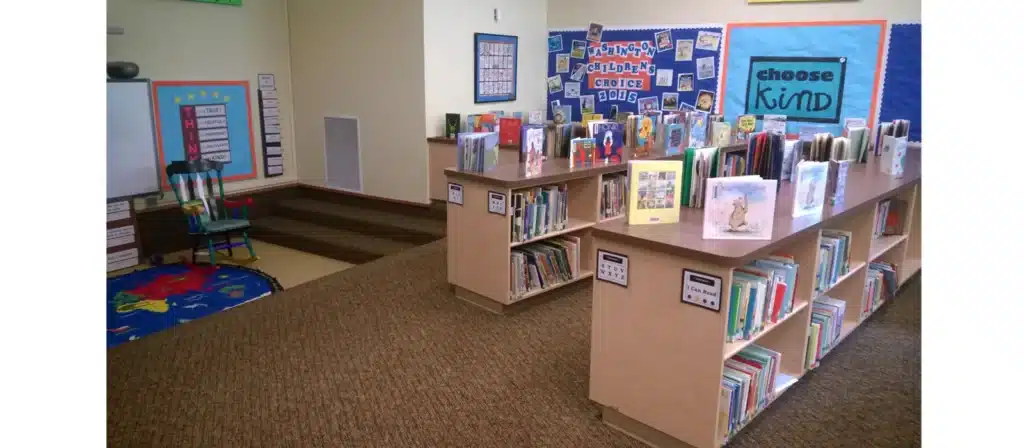
Set up kindergarten classroom library should be a haven for early readers, filled with a wide variety of books, comfortable seating, and an organized, welcoming environment.
A classroom library is the heart of literacy development in young learners. It’s where they begin to form a relationship with books and reading. A well-stocked, inviting library encourages children to explore, imagine, and develop a lifelong love for reading.
Choose books that are age appropriate, culturally diverse, and cover a range of topics and genres. Interactive books, picture books and early readers are great choices.
Organizing the Library
Organization is set up a kindergarten classroom key. Books should be arranged in a way that’s easy for young children to navigate. Use clear labels, categorize by themes or reading levels, and ensure books are within easy reach. Rotating books seasonally or according to current classroom themes can keep the library fresh and exciting.
Creating a Comfortable and Engaging Environment
The physical setup of the library is as important as the books themselves. Include cozy reading nooks, soft seating, and adequate lighting. A welcoming library space invites children to spend time reading and exploring books.
2. Kindergarten Classroom Dramatic Play Area

The dramatic play area in the kindergarten classroom is a space for imagination and social learning. Here, children engage in pretend play to develop their emotional and social skills. This area should be flexible, safe, and stocked with a variety of materials to stimulate creativity.
Dramatic play allows children to experiment with different social roles, practice language skills, and learn to cooperate and negotiate with peers. It’s a powerful tool for developing emotional intelligence and problem-solving skills.
The play area should be clearly defined and have a variety of costumes, props, and play sets. Themes can vary from a home setup to a grocery store, allowing children to explore different real-world scenarios. Ensure all materials are safe and age-appropriate.
3. Kindergarten Classroom Whole Group Area
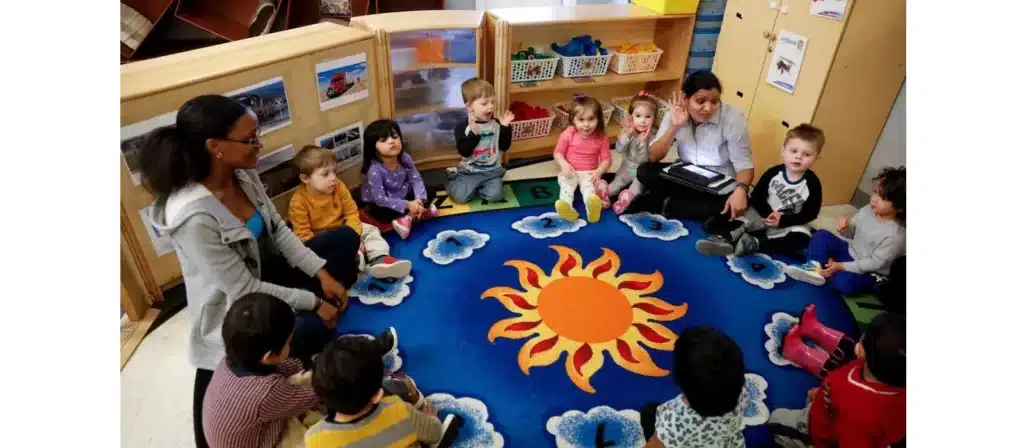
The whole group area is where the entire class gathers for various activities. This space needs to be versatile, accommodating a range of activities from storytime to group discussions. It should be comfortable and spacious enough for all children to participate actively.
This area should be open and flexible. Use rugs or mats to define the space and provide comfortable seating for the children. The layout should allow every child to see and hear the teacher without obstruction.
The whole group area can be used for a variety of activities, including morning meetings, storytime, music and movement, and educational games. Set up kindergarten classroom activities to promote group interaction and collaborative learning.
In a whole group setting, it’s important to manage noise levels and movement. Establish clear rules and routines for group time. Using visual and auditory cues can help in directing the children and maintaining an organized environment.
4. Kindergarten Classroom Organization
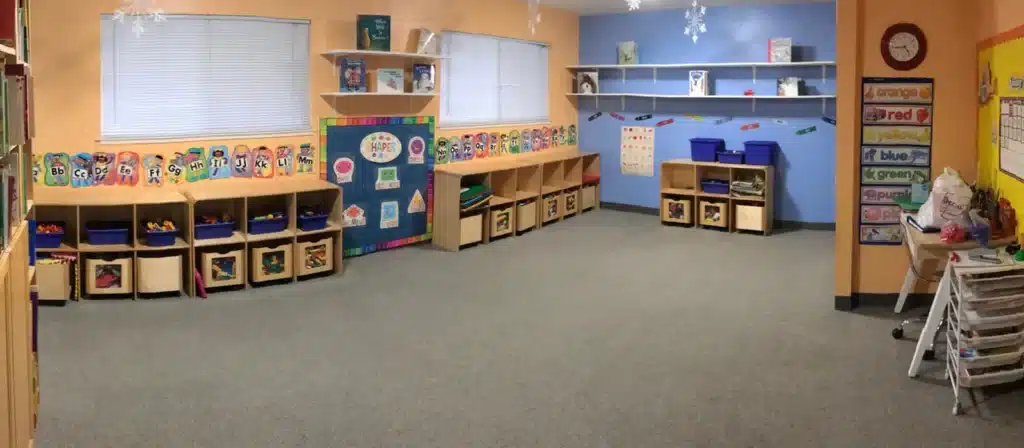
Set up an organized kindergarten classroom is key to a smooth-running learning environment. It helps in efficient use of space and time, and aids in creating a calm and focused atmosphere for the children.
Use shelves, bins, and labels to organize materials. Create clear paths for movement and ensure each area of the classroom has a specific purpose.
Organizing Materials and Supplies
Keep materials and supplies well-organized and accessible to the children. This not only promotes independence but also helps in maintaining an orderly classroom. Regularly check and replenish supplies to ensure everything is in place.
5. Writing a Classroom Management Plan
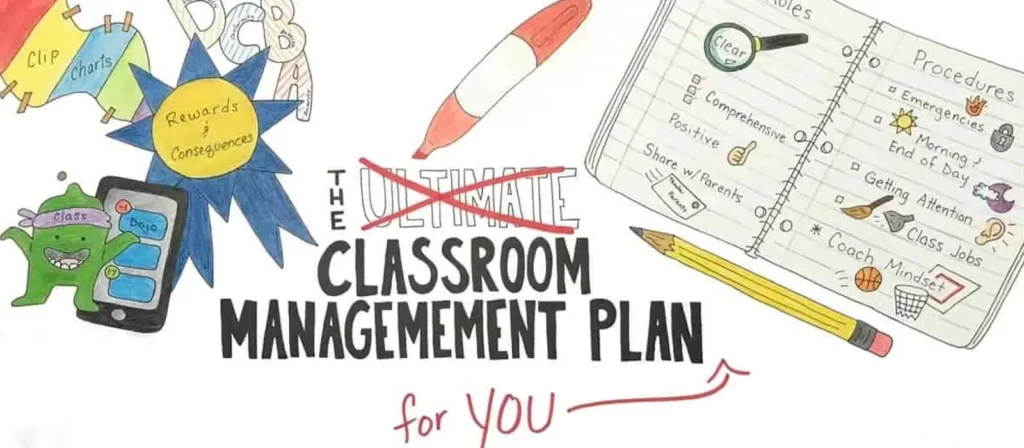
Set up kindergarten classroom management plan is a roadmap to creating a positive and productive learning environment. It outlines procedures, rules and strategies for managing classroom conduct and logistics.
Establish clear and consistent rules and expectations. These should be age-appropriate and positively stated. Involving children in creating these rules can lead to better understanding and adherence.
- Keep rules simple and age-appropriate: Develop a set of clear, concise, and easy-to-understand rules that are suitable for kindergarten-aged children. Use positive language and focus on desired behaviors rather than negative ones.
- Teach and model expected behaviors: Take time to explicitly teach and model the expected behaviors. Role-play different scenarios and reinforce positive behaviors through praise and rewards.
- Establish consistent routines: Establish consistent daily routines to provide structure and predictability for the children. This helps them understand expectations and reduces behavior issues.
- Use visual cues and reminders: Utilize visual cues such as pictures, charts, and posters to remind children of the classroom rules and expectations. These visual aids serve as gentle reminders and reinforcement.
- Implement a behavior management system: Consider implementing a behavior management system such as a reward chart or a token economy system. This provides incentives for positive behavior and allows for consistent consequences for negative behavior.
By setting clear rules and implementing effective behavior management strategies, you create a classroom environment that promotes respect, cooperation, and positive social interactions.
6.Kindergarten Classroom Safety

Safety is the basis for set up kindergarten classroom, especially for young children. A safe classroom prevents accidents and creates a secure learning environment.
Prioritizing Safety in Design
Every aspect of the classroom design should be evaluated for safety. This includes ensuring furniture has rounded corners, using non-toxic materials, and ensuring that there’s no clutter where children can trip and fall.
Regularly check toys and furniture for wear and tear, make sure all electrical outlets are covered and emergency exits are clearly marked and accessible.
Creating a Safe Learning Culture
Safety is also about setting and enforcing clear rules for behavior. This includes teaching children about personal space, safe ways to use classroom materials, and practicing emergency drills.
Students are visible at all times. You must be able to monitor the classroom well. Students who know they are not visible often misbehave.
When set up kindergarten classroom, ensure good circulation at the entrance and exit of the classroom, that there are no piles of materials, and that emergency exits are clearly marked.
7.Kindergarten Bulletin Boards
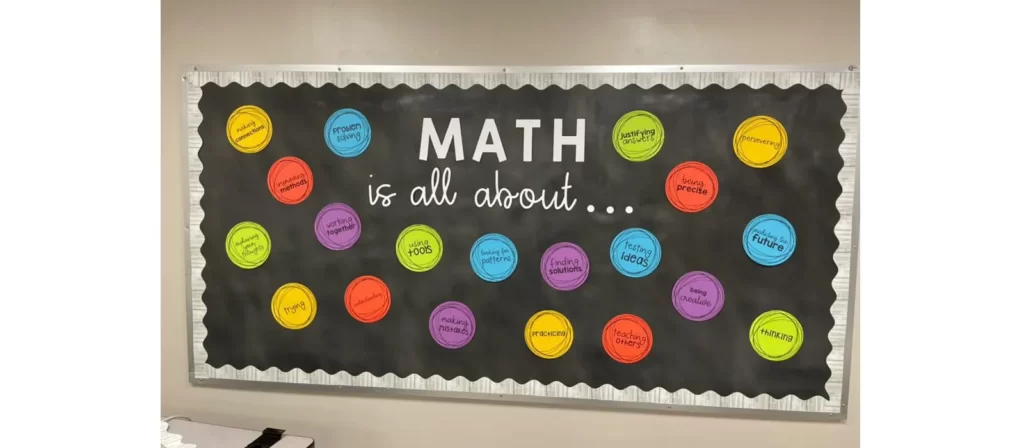
Bulletin boards are more than decorative elements; they are dynamic educational tools.
Interactive bulletin boards engage students and make learning more hands-on. They can be used for everything from showcasing student work to teaching new concepts.
Keep the classroom environment fresh and stimulating by regularly updating the bulletin boards. This could align with classroom themes, seasons, or educational topics.
8.Kindergarten Classroom Decor
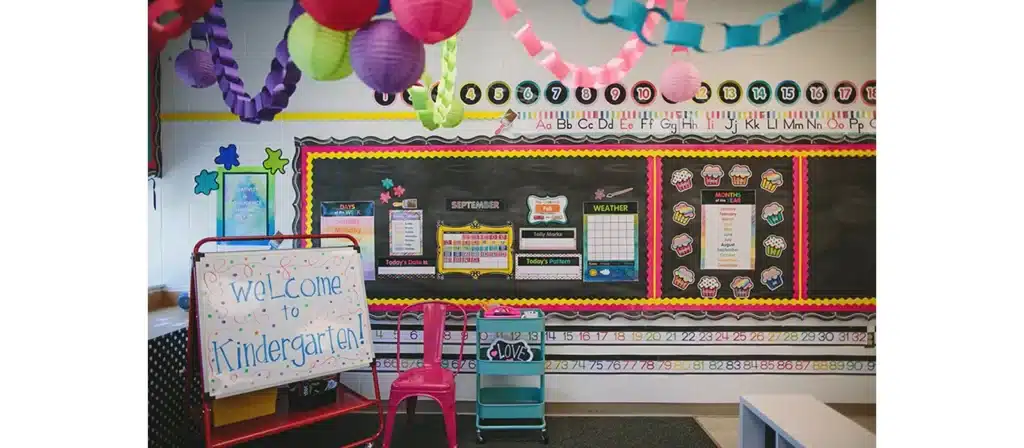
Choosing Age-Appropriate Decorations
Set up kindergarten classroom decorations should be age-appropriate, colorful, and engaging. They can include educational posters, student artwork, and thematic elements related to the curriculum.
Creating a Theme
A consistent theme can make the classroom more cohesive and visually stimulating. Themes can be based on seasons, favorite children’s books, or learning topics.
- Maximize natural light: Natural light is good for children’s health and enhances their concentration. Strategically place windows to ensure the classroom is well lit during the day.
- Lighting: Choose lighting that provides adequate and even illumination. Harsh lighting that can cause discomfort should be avoided. Consider low-heat, energy-efficient light-emitting diode lights.
- Curtains: Choose curtains that complement the theme of the classroom. They should be functional, able to control light and provide privacy when needed. Choose materials that are safe and easy to clean.
9.Consider the Traffic Flow
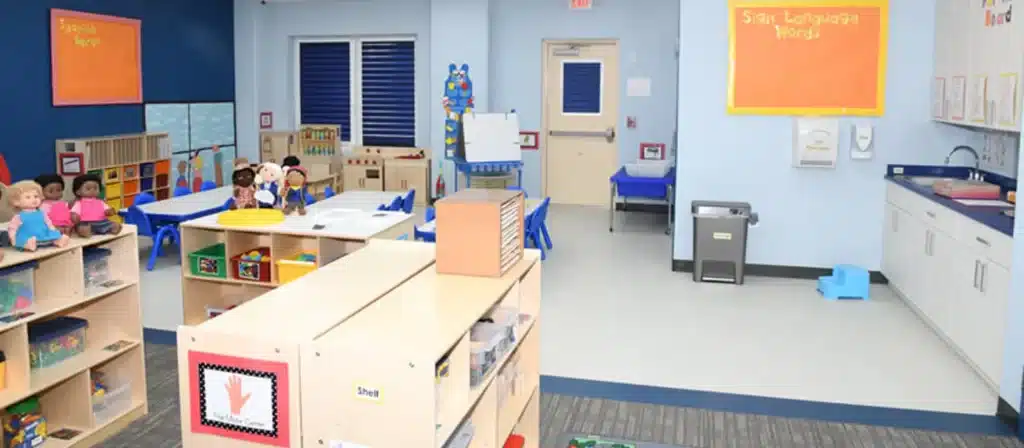
The layout should allow for smooth movement and easy access to different areas of the classroom. This includes clear pathways, strategically placed furniture, and designated areas for specific activities.
Set up kindergarten classroom requires preventing crowded areas. This might mean having multiple activity stations or spreading out popular areas like the reading corner.
In case of emergencies, it’s important to have a clear evacuation plan. This includes having unobstructed exits and practicing evacuation drills with the students.
10.Doesn’t have to be done before school starts
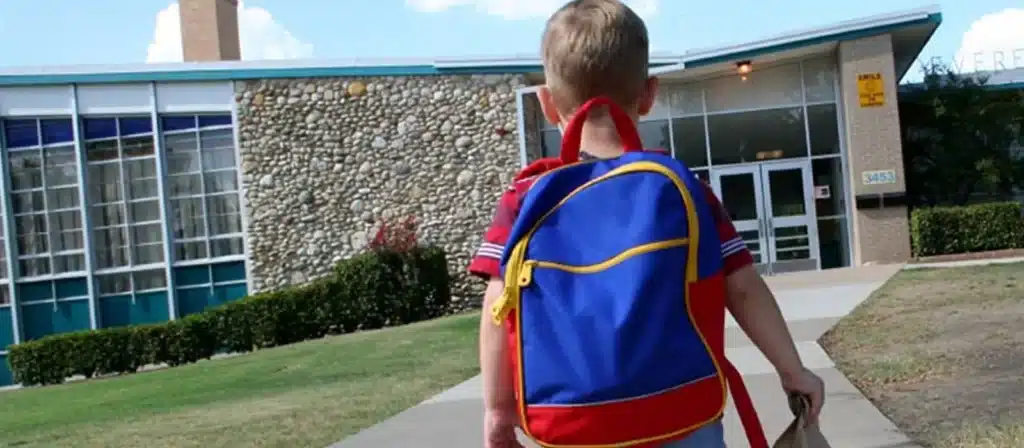
Set up kindergarten classroom is a process, not a one-time event.
Don’t pressure yourself to have everything perfect by day one. It’s okay to gradually add and adjust elements in the classroom as you better understand the needs and dynamics of your students.
Involving students in setting up and decorating the classroom can be a valuable learning experience. It gives them a sense of ownership and pride in their classroom.
Be open to making changes as the school year progresses. Flexibility allows you to adapt the classroom environment to better suit the evolving needs of your students.
11.Essential Supplies and Materials for a Kindergarten Classroom
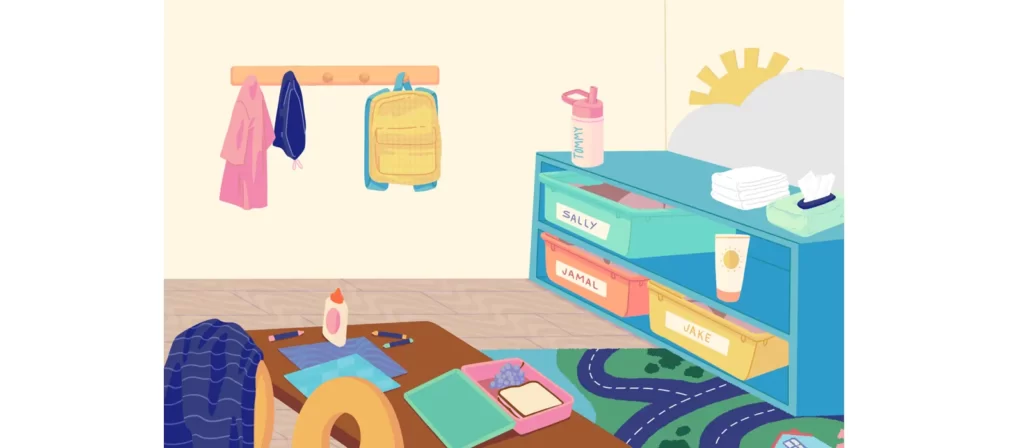
In order to set up a fully functional kindergarten classroom, you will need to gather a variety of supplies and materials. Here is a checklist of essential items to consider:
- Art supplies: Stock up on crayons, markers, colored pencils, glue sticks, safety scissors, and various types of paper. These materials will facilitate the children’s creativity and artistic expression.
- Manipulatives: Include a variety of manipulatives such as blocks, puzzles, counting toys, and shape sorters. These hands-on materials will promote cognitive development and problem-solving skills.
- Books: Create a diverse library of age-appropriate books that cater to different interests and reading levels. Encourage reading by providing cozy reading nooks and regularly rotating the selection of books.
- Writing materials: Provide an array of writing tools such as pencils, erasers, and lined paper. Introduce writing activities to develop fine motor skills and encourage early literacy.
- Sensory materials: Set up a sensory table or corner with materials like sand, water, playdough, and sensory bins filled with various textures. These materials will engage the children’s senses and promote exploration.
- Classroom supplies: Don’t forget the basics! Stock up on essentials like tissues, hand sanitizers, disinfectant wipes, and storage bins to keep the classroom clean and organized.
Gathering these essential supplies and materials will ensure that your kindergarten classroom is well-equipped to support a wide range of learning activities.
Conclusion
From designing a functional layout and selecting age-appropriate furniture to organizing designated areas for different activities and incorporating technology, each aspect of the setup process contributes to the overall learning experience.
Set up kindergarten classroom is an intricate process that requires thoughtful planning and a deep understanding of young learners. Each area of the classroom plays a crucial role in fostering a nurturing and stimulating learning environment. By focusing on these key areas, you can create a space that not only meets the educational needs of your students but also inspires and excites them.










